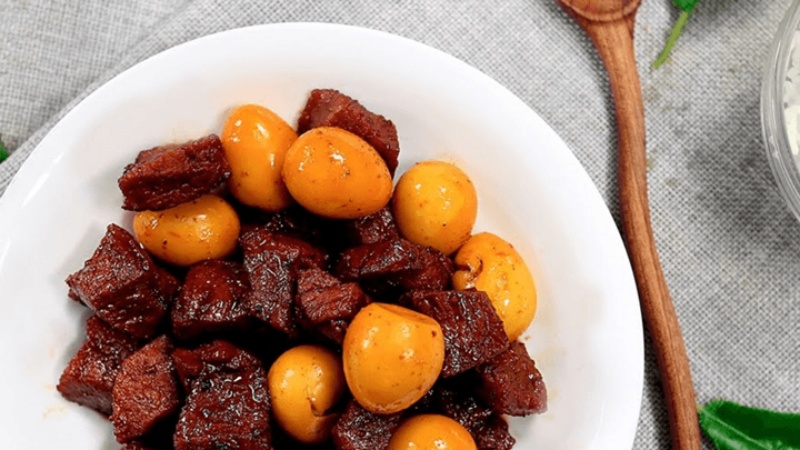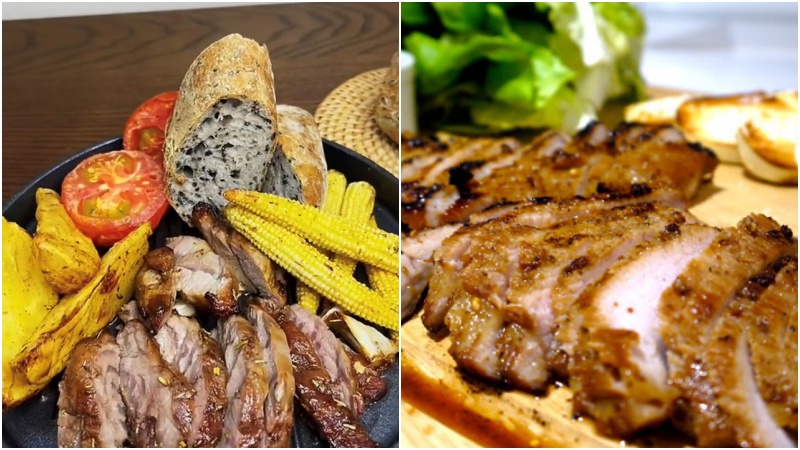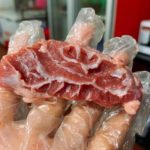Pork is an incredibly versatile meat, with a wide range of dishes that can be created from its various cuts. Some of the most popular pork cuts include belly, shoulder, loin, and ham. But have you ever heard of pork cheek, or more specifically, the “má đào”? Let’s explore this lesser-known cut and uncover its unique qualities.
1 What is Pork Cheek “Má Đào”?
Pork cheek, or “má đào”, is a less commonly known cut of pork, partly because it is often overshadowed by the more familiar pork cheek. However, the pork cheek actually consists of two parts: the outer cheek and the inner “má đào”.
The outer cheek tends to be less desirable due to its higher fat content. In contrast, the “má đào” is characterized by its soft, interlacing tendons, resulting in a tender and not at all tough or chewy texture. What’s more, a single pig only yields 200-300 grams of this delicate meat, making it a rare treat that often sells out quickly and is unknown to many.
 Pork Cheek “Má Đào”
Pork Cheek “Má Đào”
The unique combination of soft tendons and meat makes “má đào” a delight for those who prefer their meat neither too fatty nor too lean. Biting into a piece of “má đào” reveals a melt-in-your-mouth tenderness, with soft tendons that are anything but tough or chewy.
2 Price of Pork Cheek “Má Đào”
Due to its limited availability, those wishing to purchase “má đào” often need to arrive at the market early or place advance orders with their butcher.
Currently, the price of “má đào” at traditional markets is around 180,000 VND per kilogram, offering a unique and delicious dining experience.
For a more convenient option, online purchases from reputable sources are available at a slightly lower price of 90,000 VND.
 Price of Pork Cheek “Má Đào”
Price of Pork Cheek “Má Đào”
3 Delicious Dishes with Pork Cheek “Má Đào”
Braised Pork Cheek “Má Đào” with Quail Eggs
To prepare this dish, simply follow your usual braising recipe with a few adjustments. Start by rinsing the “má đào” in salted water, and boil the quail eggs, peeling them afterward. Marinate the meat with fish sauce, salt, sugar, MSG, chopped shallots, and chili.
When braising, add food coloring and briefly stir-fry the marinated meat before adding coconut water to enhance the natural sweetness of the dish. Finally, add the quail eggs, and your delicious braised pork cheek “má đào” is ready to be served! This dish offers a tender and juicy alternative to traditional fatty pork dishes.
 Braised Pork Cheek “Má Đào” with Quail Eggs
Braised Pork Cheek “Má Đào” with Quail Eggs
Stir-fried Pork Cheek “Má Đào” with Vegetables
“Má đào” is also delicious when stir-fried with vegetables, creating a unique and flavorful dish comparable to beef tenderloin. Try stir-frying “má đào” with bell peppers, peas, and corn, among other vegetables. The natural sweetness of the fresh vegetables, combined with the tender meat and tendons, makes for an irresistible and nutritious meal.
 Stir-fried Pork Cheek “Má Đào” with Vegetables
Stir-fried Pork Cheek “Má Đào” with Vegetables
Grilled Pork Cheek “Má Đào”
Unlike regular pork cuts that tend to dry out when grilled, “má đào” absorbs seasonings beautifully and remains tender. For convenience, use a pre-made grill seasoning packet, and feel free to include vegetables for a complete BBQ experience.
 Grilled Pork Cheek “Má Đào”
Grilled Pork Cheek “Má Đào”
We hope that this article has inspired you to explore the wonders of pork cheek “má đào”. Head to your local market early tomorrow and grab some “má đào” to try out these delicious recipes. Happy cooking!
Pork Sweetbread: The Delicacy You Must Try
Pork has various cuts such as the shoulder, belly, thigh, ribs, and rump. However, there is an incredibly delectable part that only weighs around 2-3 ounces, and only those who get to the market early enough can purchase it: the prized pork cheek.






































